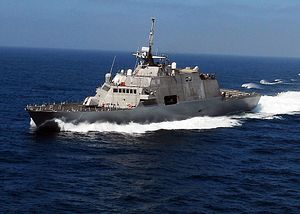By 2018 at the latest, the United States Navy plans to rotationally station four – one at a time – Littoral Combat Ships (LCS) in Singapore as part of Washington’s pivot to Asia. According to Rear Admiral Charles Williams, commander of the Seventh Fleet’s Task Force 73: “We will soon see up to four LCS here in Singapore as we rotationally deploy Seventh Fleet ships. We envision four ships here by late 2017 to sometime in 2018… By 2018, four LCS ships will be rotationally deployed here to Singapore.”
The LCS USS Fort Worth recently returned to Singapore for maintenance and refitting and will replace another LCS, the USS Freedom, which operated mainly in Southeast Asia during its 10-month mission in 2013. The 389-foot (119 meter) USS Fort Worth, only the second LCS to be deployed to the region, will patrol Southeast and Northeast Asian waters for a duration of 16 months. “The role of the US navy in both Southeast Asia and Northeast Asia is about presence. It’s about being where it matters when it matters,” Rear Admiral Williams underscored.
The U.S. Navy plans to acquire 52 LCS vessels at a total cost of $37 billion. Specifically tailored for shallow coastal waters, the 3000-plus tons LCS, which can customize around 40 percent of its volume to adapt to different mission sets (minesweeping, anti-submarine warfare, surface combat, ect.), has been a controversial naval acquisition due to cost inflation and numerous design and construction issues.
Originally the vessels prime advantage was supposed to be its speed – the LCS was meant to cruise 50 percent faster (45-knot-plus) than most other war ships. Yet, some reports have emerged that the U.S. Navy will sacrifice speed in future LCS versions and rebrand it as a frigate due to recent advances in effective counter-swarm defenses. Stars and Stripes notes that many U.S. naval officers and analysts already fear that the LCS currently operating lack the speed, range, and electronic-warfare capabilities to operate in the Asia-Pacific region.
“The reliability of the ship has already been improved,” and lessons learned have been “numerous,” Rear Admiral Williams emphasized this week in Singapore trying to silence some critics. The commanding officer of the USS Fort Worth, Matthew Kawas, further elaborated: “We started when there was only the USS Freedom, she was pretty much doing a lot of testing. She came on the deployment, she got to operate with some other navy ships. We are basically expanding what this ship can do, and testing out and learning lessons from all of our operations.” He also stated that the vessel “offers some good flexibility in that it’s a very shallow ship, almost 5 meters in draft. That opens up a large area that we just simply can’t get some of our other ships to.”
The USS Fort Worth, carrying a helicopter, an unmanned aerial vehicle (UAV), and armed with a 57 millimeter gun and 21 missiles, will be the first U.S. LCS to participate in the annual Foal Eagle exercises starting next month off the coast of South Korea. “The specific role that Fort Worth will play in Foal Eagle is really no different than any other Navy ship has for years,” Rear Admiral Williams noted. North Korea has already voiced its customary protests over U.S. participation in the naval exercise.

































